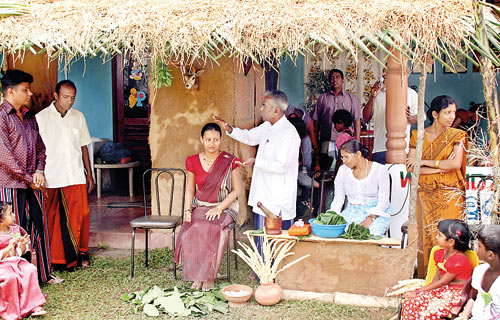Let’s get together, it’s Avurudu in the village
Aluth Avurudu rituals which touched the vital aspects of people’s lives, were the outcome of collective efforts of a village community. No other event has had the wholehearted participation of people of such diverse professions, crafts and skills to foster goodwill in the family.
Come Avuruddha, one of the earliest who made himself busy was the “Nakath Gurunnanse” – the respected village astrologer whose “nakath seettuwa” (chart) guided households to perform the Avurudu rituals to precision.

Enacting the oil anointing ritual. (File pic by M.A. Pushpa Kumara)
Going by the astrological belief that the sun in April completes its circular journey across the twelve zodiac segments and arrives in the first segment – Aries to begin a new year, the Gurunnanse worked out the astrological calculations concentrating on aspects that mattered to people. The lighting of the hearth and the boiling of milk symbolised prosperity for the household. This followed the consumption of the first meal and the money-transaction or “ganu-denu”. The anointing of the head with oil followed by the first bath was a ritual practised to bring health benefits. The “seettuwa” besides the solar movements also included the time to set out for work, directions to face when performing the rituals and the auspicious colour to wear for the Avuruddha.
Another stakeholder in the Avurudu celebration was the “vedamahattaya” or the indigenous physician whose Ayurvedic skills were sought to extract the best health benefits in the Aluth Avuruddha. He was entrusted with the preparation of the herbal oil and the “nanu” (the herbal mixture) used in the oil anointing ritual which was carried out to invoke blessings for good health and longevity.
The kinds of herbs used in the “nanu” differed each year according to the planet associated with that year. Preparations were made following astrological calculations with flowers, seeds, leaves and roots of savandara, sandalwood, kohomba, beli, irriveriya and kalanduruala. Once the oil and the “nanu” were prepared which was a sacred task, the custom was for the physician to hand it over to the village temple. The temple in fact had been the centre of action in the village during the Avurudu celebrations with monks themselves sometimes making the oil and the “nanu” preparation. Even the “nakath seettuwa” was handed over to the village temple by the “Nakath Gurunnanse” with the temple in turn disseminating “nakath times” to the people.
The oil-anointing ritual was heralded by the ringing of the “ghantaraya”which brought the villagers to the temple. At the temple, they stood barefooted on medicinal leaves with their heads touching the hanging leaves above in order that they enjoyed good health from head to foot while the application of the herbal preparation was made with a blessing by the chief monk. The rest of the monks chanted pirith in order that the ritual healed the mind and the body. The oil and “nanu” were also distributed to families who desired to carry out the ritual at home, usually by an elder.
With the approach of the Avuruddha, much awaited was the arrival of the jaggery-maker in the village with the jaggery wrapped in dried banana leaves and the treacle securely held in a bag made out of a“kolapotha” (dried palmleaf). The precious commodity went into the making of the array of Avurudu sweetmeats which continue to be identified as Lankan sweetmeats. Jaggery and treacle turned out with kithul, coconut, palmyrah or sugarcane in the meantime, were consumed as an accompaniment with curd, milk rice, coffee and tea as well.
The potter was the craftsman who found himself busy in the pre-Avurudu days. Besides making clay pots for the households to boil the first milk at the auspicious time in the New Year, he also provided the entire range of clayware for cooking, storing and other purposes replacing the old, cracked pots used in the earlier year. Towards this end, he turned the potter’s wheel in his workshop to shape lumps of clay into earthenware which he fired in his humble kiln. The range of clayware he crafted for ancient kitchens including the “kalaya” to fetch water, was the pride of the housewives of yore in the Aluth Avuruddha.


